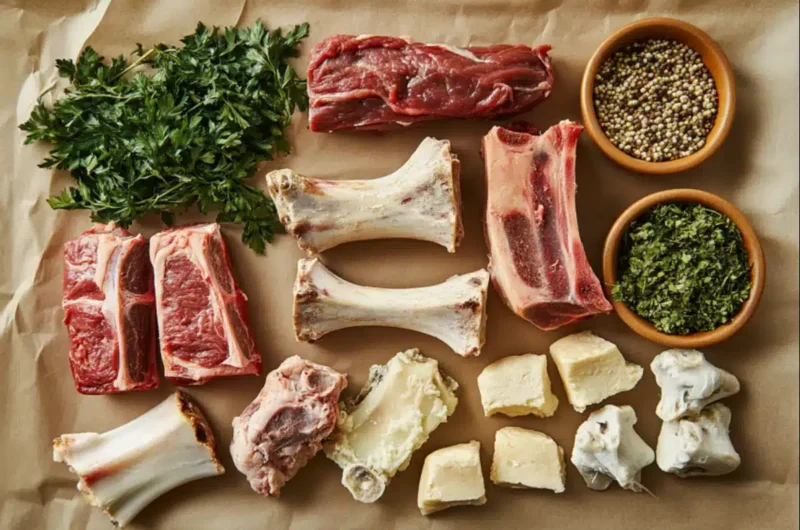Are you ready to elevate your homemade soups and broths to a whole new level of flavor? This article will guide you through everything you need to know about using soup bones. We’ll cover how to select the best bones for soup, how to prepare them, and the techniques that will unlock their incredible flavors, and the health benefits, to help you create truly memorable dishes. Let’s dive in and discover the secrets to making exceptional broths and stocks with soup bones.
What are Soup Bones and Why Use Them?
Defining Soup Bones: More Than Just Leftovers
So, what exactly are soup bones? They are not simply leftovers; they’re the bones that remain after cutting meat, often including joints, knuckles, and marrow-rich sections. These are the bones that are ideal to use for cooking because they’re packed with connective tissues, bone marrow, and other components that release incredible flavors during the cooking process. Unlike meat that’s intended for eating, soup bones are primarily used to infuse flavor into liquids. They are the key to creating the richest and most flavorful broths. Using them is a fantastic way to make the most of the entire animal, turning what might be discarded into a culinary treasure.
The Benefits of Using Soup Bones: Flavor and Nutrition
Using soup bones goes far beyond just adding flavor; it’s about adding a wealth of nutrients to your cooking, as well. The slow simmering process extracts collagen from the bones, which transforms into gelatin, giving your broth that smooth, velvety texture, while also enriching it. These bones are a source of essential minerals like calcium and phosphorus, which are released into the broth. This is an economical and sustainable way to create a nutrient-rich broth, while also minimizing food waste. By using soup bones, you are not only enhancing the taste of your dishes, but you are also maximizing their nutritional value.
Selecting the Right Soup Bones
Types of Soup Bones: Beef, Chicken, and More
You can find a variety of soup bones, each offering a unique flavor profile. Beef bones, such as shanks, knuckles, and oxtails are ideal for creating a rich, full-bodied beef broth with lots of depth. Chicken bones, especially the backs and necks, are more delicate, and will produce a lighter broth that’s still full of flavour. Don’t forget you can also experiment by using lamb bones if you want to add a unique twist to your broths and stews. Selecting the right bones is important, because it will have a direct impact on the taste of your final product.
Marrow Bones and Knuckle Bones: Flavor Powerhouses
Marrow bones are packed with rich, fatty marrow that will add a luxurious richness and depth of flavor to your broths. Knuckle bones, are high in collagen and contribute to a thick, gelatinous texture, while releasing lots of flavor. Both of these are a great source of flavor and will enhance both flavor and texture, making them a highly desirable option, as you are making homemade stock.
Where to Source Your Soup Bones: Butchers and Beyond
When looking for quality soup bones, your local butcher shop is an excellent source for high-quality options. They often have a variety of bones that are ideal for making broth. You can also explore farmers’ markets for bones directly from farms, or you can find some at the meat department of a grocery store. In some cases, you can also ask your butcher to cut the bones in smaller pieces, if you prefer. And, if you find a good deal, don’t hesitate to buy a larger amount and freeze it for later use. Choosing a reliable source for your bones for soup will guarantee the best results in your broths.
Preparing Your Soup Bones for Maximum Flavor
Roasting Soup Bones: Enhancing the Depth of Flavor
Before simmering your soup bones, roasting them is a crucial step to enhance their flavor. By roasting them in the oven at 400°F (200°C) for 20 to 30 minutes, you can achieve a deep, caramelized flavor, which elevates the overall taste. You must turn the bones halfway to ensure even browning. This process also adds color to your broth.
Blanching Soup Bones: For a Cleaner, Clearer Broth
While roasting is important to boost flavor, blanching is also very important if you want to achieve a cleaner, lighter broth. To blanch your soup bones, place them in a large pot of cold water, bring the water to a boil, and then allow them to boil for approximately 5 minutes. Remove the bones from the pot, and thoroughly rinse them under cold water before proceeding to the simmering process. Blanching helps remove any remaining impurities from the bones and produces a clearer broth. Also, this removes excessive fat from the bones, if you prefer a less fatty broth.
Making Your Broth: The Simmering Process
Combining Soup Bones, Aromatics, and Water
Now that your soup bones have been properly prepped, it’s time to get started. Place the roasted or blanched bones in a large pot. Then, add your favourite aromatics, such as chopped carrots, celery, onion, garlic, bay leaves, thyme, and rosemary. These aromatics will add complexity to your broth. Then, cover everything with cold water, making sure that all the bones and vegetables are fully submerged, and you are all set for the simmering process. The cold water helps extract the flavors gradually and gently. Adding hot water can impact the process, so it is preferable to use cold.
The Art of Simmering: Timing and Temperature
The proper simmering time for soup bones can vary according to their type. Beef bones will benefit from a longer simmering time, which can be around 4-6 hours. On the other hand, chicken bones might only require 2-3 hours of simmering. You must maintain a gentle simmer, and not a vigorous boil, because a vigorous boil can produce a cloudy broth and extract unwanted compounds from the bones.
Skimming and Reducing: Techniques for a Perfect Broth
Skimming is an essential step for any clear broth. Throughout the simmering process, you will notice some impurities rising to the surface in the form of foam or scum. You must use a ladle or spoon to remove these impurities, because this will lead to a clearer broth, free from unwanted particles. Reducing your broth after straining is also an important step for intensifying the flavors. You must simmer the strained broth uncovered for an additional 30 minutes to 1 hour, until you get a more concentrated and flavorful final product.
Straining and Storing Your Homemade Broth
Straining Your Broth: Removing Solids
Once the simmering process is completed, it is time to strain your broth and separate the solids. Use a fine-mesh strainer or a cheesecloth-lined colander to carefully remove all the solid particles, including bones, vegetables, and herbs from the broth. This step is essential for achieving a smooth and clear liquid, free of any bits and pieces. Proper straining is very important to ensure that your finished product is a silky and pristine broth.
Proper Storage for Fresh and Flavorful Broth
After straining, allow your broth to cool down completely before storing it. You can refrigerate the broth for up to 4 days, making sure that you place it in airtight containers. If you want to preserve it for a longer period, freezing is a good option, and it can be kept frozen for up to 3 months without losing its flavor. For easy use, you can freeze the broth in ice cube trays, and then store the cubes in a freezer bag. This method is ideal for those who only need a small amount of homemade broth.
Uses for Soup Bones Beyond Broth
Soup Bones in Other Dishes: Versatile Cooking
Soup bones are not limited to just making broth. You can repurpose roasted marrow bones by adding them to a rich and flavorful risotto, or you can use your leftover bones to make a gravy or a sauce, by adding more liquid, and a thickener, like flour or cornstarch, and letting it simmer.
Making a Bone Broth: Extra Nutrients and Health Benefits
Bone broth is made following the same guidelines as a regular stock, but it is simmered for much longer, which is sometimes up to 24 hours. This prolonged cooking process extracts more collagen, gelatin, and minerals from the soup bones, resulting in a more concentrated and nutrient-rich broth. This nutrient-rich broth is a good option for people looking for added health benefits, in their regular diet.
Health Benefits of Using Soup Bones
Collagen and Joint Health: Benefits from Soup Bones
Soup bones are an excellent source of collagen, which is essential for maintaining healthy joints. Consuming broths made with soup bones, especially bone broth, can help improve joint flexibility and reduce inflammation, supporting overall joint health. If you are looking to improve your joints’ health, a homemade broth with collagen is a great way to get more natural collagen through your diet. This will also help with joint mobility and pain reduction.
Gut Health and Immunity: Using Soup Bones
Broths made with soup bones are very beneficial for your gut health and overall immunity. The amino acids and minerals, found in a bone broth and regular broths made with soup bones support a healthy gut lining, reduce inflammation, and support the immune system. Making your own homemade broth is a great way to ensure that you are getting a regular dose of nutrients that will benefit both your gut and your immune system.
for more recipes: www.allrecipes.com
Frequently Asked Questions About Soup Bones
Can I use leftover cooked bones for soup?
Yes, you can use leftover cooked bones for soup, and they are a great way to avoid food waste. However, these bones might not have as much flavor as raw bones that are roasted or blanched first, so you will need to add more seasoning and aromatics to achieve the desired flavor.
How long can I simmer soup bones for broth?
The best simmering time for soup bones can vary. For chicken bones, you must simmer them for 2-3 hours, while beef bones will need a longer simmering period, between 4-6 hours. You must always maintain a gentle simmer, and make sure the liquid is not boiling vigorously.
What are the best vegetables to add to broth?
The best vegetables for broth are the classics: carrots, celery, onion, and garlic. However, you can also add leeks, parsnips, and mushrooms for a more complex flavor. If you prefer to use herbs, you can also add fresh or dried herbs, such as bay leaves, thyme, rosemary, and parsley.
Can I freeze soup bones for later use?
Yes, you can freeze soup bones for later use. Place them in a freezer-safe bag or container, and they can last for up to 3 months without losing their quality. This way you always have soup bones available when you want to make broth.
How do I know if my broth is good?
A good broth will have a rich, deep color, and a savory aroma. It must also have a good amount of gelatin, which will be noticeable once the broth cools down. The texture should be smooth, not cloudy, with all flavors perfectly combined. The taste should also be complex and savory, but not overpowering.
Is bone broth the same as regular broth made from soup bones?
While both bone broth and regular broth use soup bones, bone broth is simmered for a much longer period, to extract maximum nutrients, specifically collagen. Regular broth is simmered for a shorter time, usually 2-6 hours, and results in a less concentrated product, that is still very flavorful. Bone broth is generally more nutrient-rich, due to this prolonged cooking time.
Conclusion
Using soup bones is a simple yet powerful way to enhance the flavor and nutritional value of your homemade soups and broths. By understanding how to select, prepare, and simmer these bones, you can create exceptionally rich, flavorful, and healthy dishes. From traditional broths to bone broth and other uses, the versatility of soup bones is undeniable, and they are also a great way to reduce food waste.






